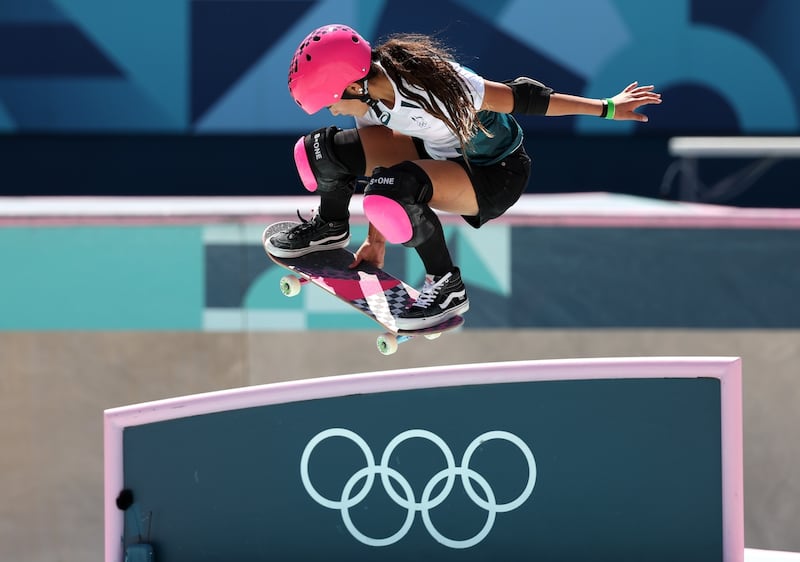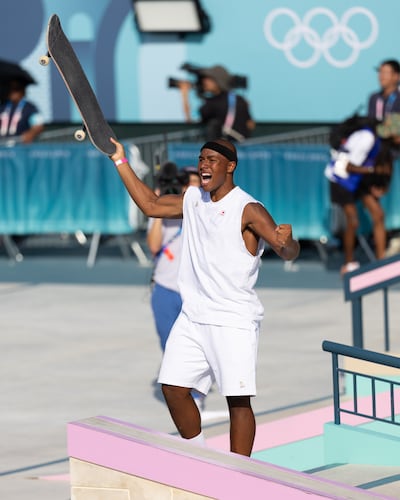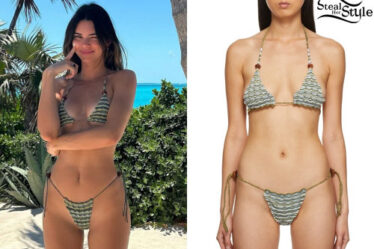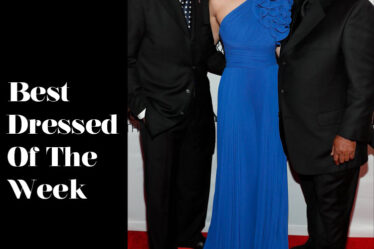
When the men’s park skateboarding finals took place at the Olympics yesterday, skaters like Keegan Palmer and Tom Schaar didn’t compete wearing cult skateboard brands like Supreme, Palace or Dime.
Instead, many skaters wore kits from larger country-team sportswear sponsors like Asics and Adidas. While there were skaters competing in Vans sneakers, riding skateboards outfitted with wheels by heritage skate brands like Spitfire and wearing kits by skate-focused footwear labels like Nike SB, outfits from the games didn’t look like what skaters wear on the cover of Thrasher magazine.
Since skateboarding’s introduction to the Olympics at the Tokyo Games in 2021, the sport has become another opportunity for brands looking to the global event as a way to capture viewers’ attention and get exposure. Dior has turned to French skaters Aurélien Giraud and Louise-Aïna Taboulet to serve as brand ambassadors. Polo Ralph Lauren similarly signed up Jagger Eaton, who won a silver medal in men’s street skating last week.
But noticeably absent are many of the brands and clothing labels that shape skateboarding’s subculture. Palace and Dime are not creating Olympic marketing moments. Supreme hasn’t touched the games, even though the two-time Japanese gold medalist Yuto Horigime wears the brand and appears in the label’s skate videos. Even Vans, whose history within skateboarding stretches back to the pioneering Z-Boys in the 1970s, is only present through established footwear contracts with some of the skateboarders competing.
The disconnect between skate brands and the games spotlights what happens when a subculture becomes mainstream. At the Olympics, the laissez-faire attitude of skateboarding must abide by complicated rules for Olympic kits, skate around larger country-team sponsorships by major brands and consider the audience that Olympic skating is even for. That may not be the same audience these brands try to serve.
“As far as our demographic, I think most of our fans probably lean into the Olympics as something over here that they’ll probably pay a little bit of attention to, but it’s not their main focus,” says Damon Thorley, a brand manager for Spitfire and Thunder Trucks at the heritage skateboard company Deluxe Distribution. “What they’re into is smaller, local scenes, and what’s going in Thrasher magazine on Monday is maybe more important to them or more interesting.”
Riding Against Larger Sponsorships
Thorley said the company’s main audience is skateboarding’s core retail industry comprising small shops serving the local community. It still supports a lot of riders involved in the Olympics, but the global event is not the best venue for it.
Vans sneakers appeared on skaters from Japan, Brazil and Australia at the games, but it still opted not to design kits for any country’s skate team in Paris, even though it previously made a kit at the Tokyo games in 2021 for the Finnish skater Lizzie Armanto. Justin Villano, Vans’ global director of brand management for skateboarding, said kit opportunities seem “short-sighted” when the sponsor of a country’s larger Olympic committee will be the brand athletes wear on the podium as medals are awarded. When Australia’s Arisa Trew, who is sponsored by Vans, accepted the gold medal for women’s park skateboarding on Tuesday, she wore Asics from head to toe.
However, the shoes she wore to get that medal were Vans. Instead of making kits, Vans opted to support athletes with footwear sponsorships established long before the Olympics such as Trew — the first woman skateboarder to land a 900 — and Brazil’s Pedro Barros, who has been a Vans skate team member since 2009.
“We chose to focus on our existing initiatives across product and brand and not really concern ourselves with being opportunistic around the games,” Villano said.
Footwear sponsorships are a low-stakes opportunity for skateboard brands because sneakers are categorised by the International Olympic Committee as “sports equipment” and do not need to align with a country or National Sports Federation sponsor. The only rule for footwear worn by skateboard athletes is that the shoe must have been released for retail six months before the games.
Country sponsorships are just one factor that can make it harder to stand out, though. Villano said it’s also challenging for brands that aren’t official sponsors of the games like LVMH to activate on-the-ground in Paris and break through the noise. That’s especially true for smaller labels.
“When there’s revenue to be made, you get the biggest brands competing, and even the biggest skate brands aren’t monsters,” said Nate Orton, co-founder of Melbourne-based skateboard brand Ichpig, which sponsors Team Australia skateboarder Keefer Wilson. “How can skate brands be represented? At the Olympics, it’s monopolised.”
Rules for a Sport With None
The challenges of creating a kit may also keep some brands away.
Skateboarders never needed to wear a strict uniform until the Olympics. At the games, the street style associated with skateboarding is exchanged for uniforms that are designed under fixed rules and regulations set by the International Olympic Committee. Kit deals, from start to finish, can take up to two years when accounting not only for design approvals but also negotiations and commercial agreements with National Sports Federations and National Olympic Committees.
Cariuma, a six-year-old Brazilian skate footwear brand, spent nearly two years making kits for Slovakia, Portugal and the Netherlands. Co-founder Fernando Porto said it was a significant investment and emphasised that timing and ample in-house resources are imperative for a smaller brand to pursue Olympic kits opportunities like major sportswear brands.

“You have to get into an agreement and a contract with the federations. We have to pay for that,” Porto said. “Internally, we had a team focused on this for almost a year — an exclusive team that was doing this thing to make sure it happened the way it happened on time.”
In that context, it may not be so surprising that heritage skateboard brands Spitfire and Venture are unlikely to pursue kit deals, even while Japan’s Horigome won a gold medal riding a skateboard outfitted with those brands’ wheels and trucks.
“I would say, never say never … But I think currently it’s a bit out of our wheelhouse,” said Thorley of Deluxe Distribution. “As far as the scale of that stuff goes. We are a big heritage company within the skateboard industry, but we’re not on the level of the large shoe brands.”
A Split Audience
Of course, even if a brand wants to create a team kit, it has to get the deal. The governing body behind a country’s athletic teams may have its own priorities, however.
OVO is a brand better known for its association with the Canadian rap superstar Drake rather than Canadian skateboarders, who probably have closer ties to a brand like Montréal-based label Dime. Yet, it was Canada Skateboard’s “number one pick” for an Olympic kit partner, according to the organisation’s executive director, Hagan McCreath, partly because it was a homegrown Canadian brand that achieved global recognition.
“Skateboarding is not just a sport. It’s a lifestyle, and we felt that aligned well with what OVO was about,” said McCreath. “This is the pinnacle of lifestyle and apparel brands in Canada. This is current, very contemporary, and that is somebody that we want to work with.”

McCreath also noted that OVO was prepared to go through the long process of designing a kit. The partnership produced collaborative commercial merchandise released in June through OVO’s channels and raised social media awareness around Canada Skateboarding. Drake shared a Canada Skateboard Instagram post on his IG story when Team Canada’s skaters were competing at the Olympic Qualifier Series in Budapest.
“The whole reason why we got together was to celebrate skateboarding and our country,” said OVO’s founder, Oliver El-Khatib. “It was really to just try to help use the platform that we’ve created to celebrate these athletes who are now being recognised at the highest level of the sport.”
In 2028, the Olympics will move to California, the US state where skateboarding was born, making it likely an even bigger opportunity for brands. Even then, however, brands will need to consider that Olympic skateboarding is not one-to-one with the subculture of skateboarding.
“I think it is a part of skateboard culture just like competition is a part of skateboard culture. I do not think it is an accurate description of all of skateboard culture,” said Vans’ Villano, adding, “I hope to see this sport continue to grow because of the Olympics. And we hope that that provides more opportunity to our skaters and all the skaters around the world.”


